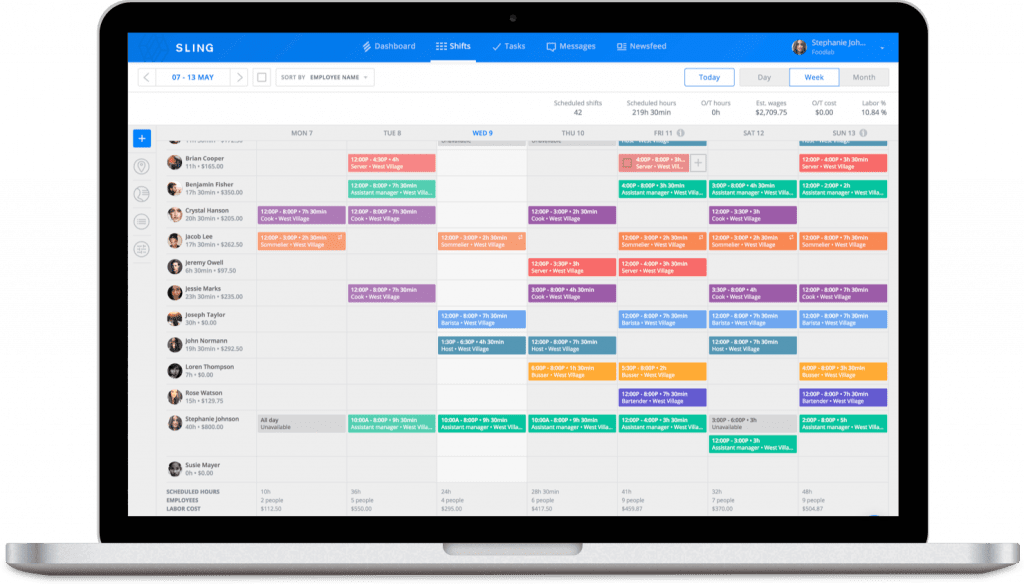Onboarding Checklist: How to Onboard Your Employees the Right Way
Your onboarding checklist should be more than just showing a new employee their ...

Want the best results from your onboarding process? Create a new hire checklist.
In this article, the workforce-management experts at Sling offer tips for onboarding employees the right way.
A streamlined and successful onboarding process starts well before the employee’s first day.
To start, give them access to your business newsfeed beforehand so they can get an idea of what goes on day-to-day in your business. Have them fill out as much of the necessary paperwork as possible so they can focus on more important issues when they arrive on-site.
It’s also beneficial to send them an email the week before they are scheduled to arrive that includes essential information, such as:
Including new hires in the loop and providing them with essential information before their first day can help alleviate much of the stress and anxiety that all new employees feel.

When you send your new hire the informational email mentioned in the previous section, send an email or memo to your existing team as well.
Be sure to include information such as:
By including this step on your new hire checklist and preparing your team members for the arrival of a new employee, you can make the transition easier for all involved.
If your business has assigned desks or workspaces for each employee, prepare one for the new hire before they arrive. If your business uses another form of workspace allocation — such as hot desking or hotelling — reserve a spot for the new hire so you don’t run out of space.
If your business doesn’t have desks or workspaces at all, prepare a locker or storage bin for the new employee so they have a place to put their stuff when they arrive.
And if you want to go the extra mile, write a small note and include a “Welcome aboard!” gift somewhere in their personal space.

Depending on the type of business you run, ready the necessary technology and access before the employee arrives.
Be sure to prepare such items as:
By preparing these details before the team member arrives, their first day will go smoothly, and they won’t have to wait for critical tools they need.
To make your new hire checklist and onboarding as stress-free as possible, avoid bringing in the new employee during your busy time of the month or right before an important deadline.
If something goes wrong during their first day — like the network going down or a project going south — try to insulate the new employee from these issues so that they don’t feel overwhelmed.
Doing so will create a good first impression that will make the team member feel comfortable in their new position.
You can do much of the onboarding work beforehand by creating an employee handbook and supplying it to the new employee or by giving them access to it on your company network when they first arrive.
Let them know that the employee handbook will answer many of their initial questions and provide information on such things as:
When you cover the most frequently asked questions in your employee handbook, you don’t have to spend valuable time verbally communicating that information to the new employee.

Some paperwork is necessary on the employee’s first day, but be sure not to overwhelm them with it. With the help of digital tools, much of what you need the new hire to complete can be done before they arrive on-site or start working.
If there’s still a considerable bit of paperwork left to complete, have them fill out one or two forms a day instead of all at once if possible.
You might also consider letting the employee take the paperwork home to read and fill out or make it available online. That way, the new hire doesn’t feel buried in stacks of forms right out of the gate.
When employees first arrive, they need something to work toward. That’s why setting goals is an essential part of the onboarding process and should be on everyone’s new hire checklist.
Keep the goals you set for your new team member in harmony with the other strategies you’ve set for your company (corporate level strategy, business level strategy, and functional level strategy) so that any progress they make also benefits your business.
A big part of your new hire’s success — and the success of your team and your business — depends on the support of the people around them. That’s why it’s essential to introduce all new employees to the team right at the start of your new hire checklist.
Not only will this ensure the smooth integration of the new employee, but it will also improve the work performance of your existing team members. Don’t wait until the end of the onboarding process to introduce your team — do it first thing.
A great way to do this is to get your new hire involved in your company culture in the first few hours after they arrive.
Consider arranging a coffee-and-donuts get-together or some other social mixer as a simple way for the new hire and your existing team to get acquainted with one other.

Computers play an integral role in the day-to-day life of your employees and the smooth operation of your business.
Take the time to get the new hire set up on your company network (or logged into their company computer), and then give them some instruction on how to access necessary programs, where to look for shared files, and how to navigate to their personal storage space.
The last step on your new hire checklist is to wish the employee well and turn them loose to get to work.
Depending on the complexity of the task, the amount of instruction you’ve given, and the new hire’s experience, you can either leave them on their own or partner them with another team member who can provide guidance, answer questions, and train the employee to do the job right.

One of the best ways to perfect your new hire checklist is with scheduling. Setting aside time for each step of the process — and sticking to it as much as possible — will ensure that you get through your list in one or two workdays, and your new hire doesn’t feel rushed or slighted.
Whether you’re organizing an employee’s first day, or their work schedule for the next few months, the Sling app can help.
Sling makes it easy for you — the manager or owner — to keep your workforce management organized and optimized at all levels of the schedule-making experience.
Sling’s onboarding artificial intelligence provides suggestions for the perfect fit and even notifies you if you double-book an employee or schedule them when they’ve asked for time off.
From the employees’ end, Sling gives them the power to request time off, specify days they can’t work, and even find substitutes for their existing shifts so you don’t have to deal with every little bump in the road.
And with other advanced features — including a built-in time clock, cloud-based storage and access, budgeting and labor cost tools, reporting, task list, newsfeed, and powerful communication tools — Sling is a one-stop scheduling solution for the 21st century and one of the best ways to streamline and facilitate your new hire checklist.
For more free resources to help you manage your business better, organize and schedule your team, and track and calculate labor costs, visit GetSling.com today.
See Here For Last Updated Dates: Link
This content is for informational purposes and is not intended as legal, tax, HR, or any other professional advice. Please contact an attorney or other professional for specific advice.
Schedule faster, communicate better, get things done.